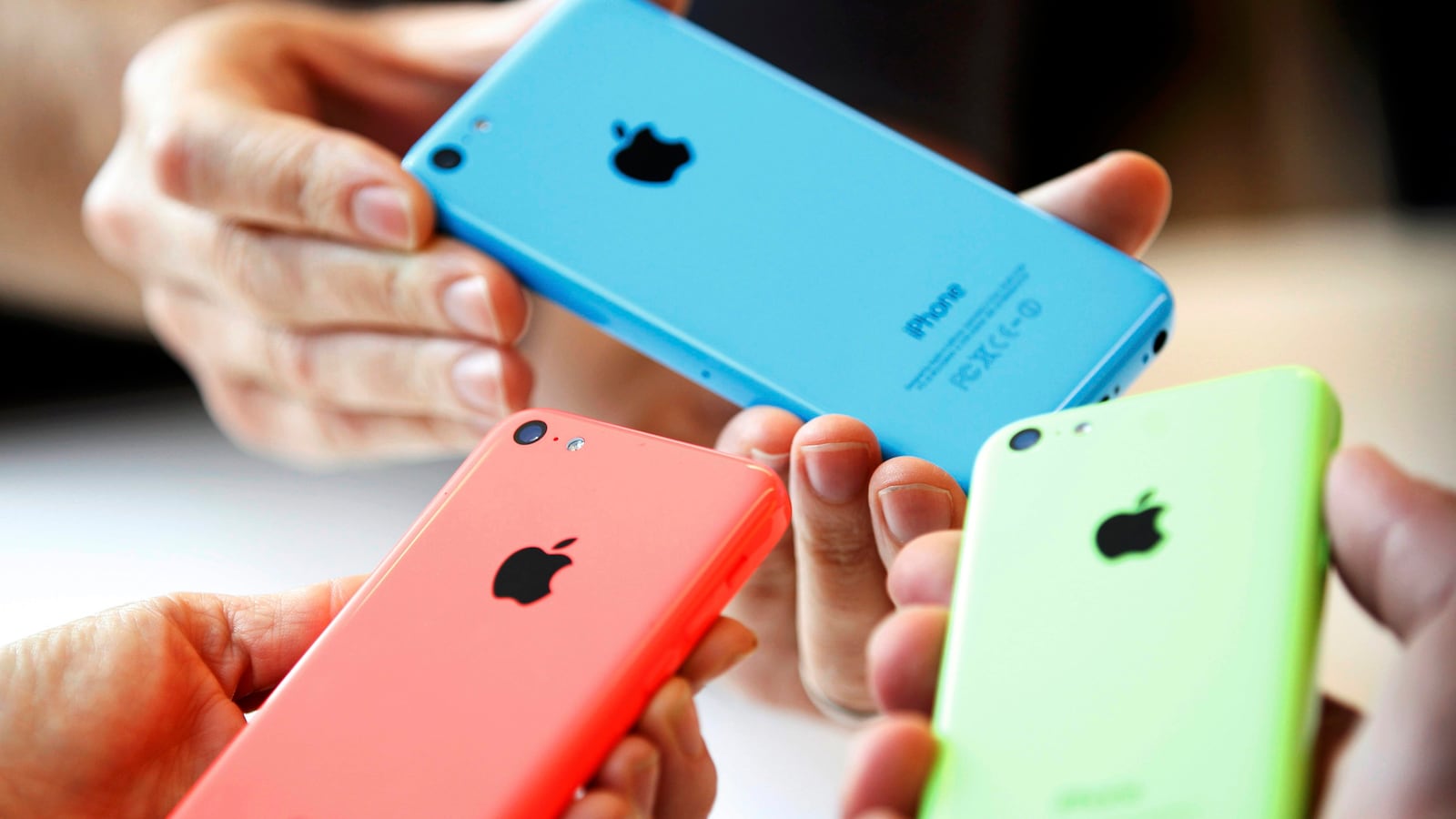Well that was an expensive product launch. On Tuesday, Apple unveiled two new iPhones, the “cheaper” 5C and the whiz-bang 5S, or as my colleague Winston Ross dubbed them, the “cheap” and the “fancy.”

Tech fanboys and fangirls marveled at some of the new features—new colors for the shell! Thumbprint security! But investors were less impressed. The company’s stock, which was trading at $505 in the middle of the day, closed at $494.64. On Wednesday morning, after investors slept on it, they decided to dump the shares like a cheap BlackBerry. By noon, the stock was off another $29, at $465.55. That decline—from $505 to $465.55—is a fall of 7.8 percent in about 24 hours, and a reduction of $35 billion in Apple’s market value.
What accounts for the fall? It could be that this was another case of investors buying the rumor and selling the news. Apple’s stock had run up sharply in the last few weeks as anticipation built surrounding the big reveal.
But I’d suggest something else is at work. It could be that investors are coming to grips with the problem facing the present—and the future—of the iPhone. It’s a rather expensive device. In the wealthy, developed economies where Apple has the strongest market positions, incomes of typical consumers aren’t rising. In the huge developing markets where Apple has a minimal presence, incomes of typical consumers are rising—but they’re nowhere near sufficient to enable them to afford Apple products. And Apple isn’t (yet) willing to meet customers where they are.
Let’s review. In the U.S., the new iPhone 5C costs $99 with a contract, while the new iPhone 5S costs $199 with a contract. That sounds cheap. But don’t be fooled. Those prices are only available when you sign up for a lengthy voice and data contract. At Verizon, such plans can cost $100 per month and up. Apple sells the device to the phone company, which recoups the cost of the device by marking up the cost of its voice and data service. The cost of the device, in other words, is embedded in the contract. In order to get the $99 iPhone, a customer must commit to spending $1,000 or more with a service provider over the course of a year.
The actual retail cost of the phone is much higher. According to Ian Sherr and Greg Bensinger of The Wall Street Journal, an iPhone 5C sold without a carrier subsidy will cost $549 in the U.S. That’s a lot of money when you consider that the typical American worker makes $829 per week. Worse, as I’ve written many times, the failure of American companies to raise wages for typical workers over the last several years has rendered workers increasingly unable or unwilling to afford the products and services that American companies make, market, and sell. Well-off Americans can buy a lot of iPhones and iPads. But if you want to be a mass business, and you want to keep growing off a very large base, it’s very hard to post impressive numbers if underlying incomes aren’t rising. Especially when you make a discretionary product. Everybody may need a mobile phone in America, and many people may need a smartphone. But very few people really need an iPhone. The pricing of these new products doesn’t do much to alter this equation.
Apple also faces a much worse problem in larger and more rapidly growing markets overseas. For the first time, yesterday, Apple formally held a product launch in Beijing. This was a recognition by Apple that the world’s largest country (by population) and second-largest country (by size of its economy) is a vital market. But Apple is poorly equipped to compete in China—and in other developing economies where lots of potential consumers live.
The great story of our current age is the economic growth that has raised tens of millions of people up from abject poverty each year. But the world—including China—still has a very, very long way to go. It is easy to be deceived by the gleaming skyscrapers of Beijing and Shanghai, by the nation’s 1 million millionaires, by the fact that Apple stores do big business in the country. But China is also a country in which McDonald’s and KFC are aspirational brands, in which per capita income was $6,091 last year, according to the World Bank. In 2011, I visited a village outside of Xian where electricity had just recently arrived and where elderly, toothless people subsisted on about $15 a month in pensions. There are hundreds of millions of people who live like this in China.
Apple can make lots of money selling expensive iPhones to China’s nouveaux riches, but there’s a limit to that market. The Journal notes that “the iPhone 5C will cost about $733 without a carrier subsidy in China.” (Typically, in China, consumers pay the purchase price for the phone and then get rebates in their bills over time.) Think about it: the retail price of the iPhone 5C is about 12 percent of the typical Chinese person’s annual income. Meanwhile, competitors have been blanketing China with cheaper smartphones. “Samsung, for example, offers smartphones in China, India and Indonesia for less than $100, without a carrier subsidy,” the Journal reported.
Indeed, the world’s poor and not-so-poor are swapping in their cheap mobile phones for cheap smartphones, and Apple is missing out. “Once the world’s top smartphone maker by unit shipments, the iPhone’s sales now account for 19% of the market, while Samsung represents nearly 32 percent, according to Gartner research,” Sherr and Bensinger write in the Journal. According to research firm Canalys, Apple’s market share in China was a mere 5 percent in the second quarter.
And keep in mind that China is one of the best-off of the giant emerging markets. India has an annual per capita income of less than $1,500. In Indonesia, per capita income is about $3,500. Sub-Saharan Africa is the most rapidly growing region in the world, and perhaps the one with most promise. It is virgin territory to most American brands. But incomes there aren’t high enough to support widespread consumption of luxury goods. Nigeria’s per capita income is about $1,500.
In many ways, Apple enjoys a remarkable and enviable position—it has a wonderful brand, a massive and loyal fanbase, and a $145 billion pile of cash that continues to grow. But when it comes to its device business, it is caught between a rock and a hard place. The incomes of typical consumers in the wealthy, established markets—the U.S., Europe, and Japan—aren’t rising. And incomes in the massive developing markets, where millions of consumers are rapidly entering the smartphone market, aren’t sufficiently high to let the typical consumer afford Apple products. These two phenomena leave Apple vulnerable to cheaper, aggressive competitors.
Time may iron out these wrinkles. Incomes in China, India, and Indonesia will eventually—eventually—rise. Incomes in the U.S. and Europe may start to rise again, too, but if only companies (like Apple) decide to pay their workers more. But that will take a while. In the meantime, if Apple wants to compete and grow, it may have to cut prices and accept lower margins. Or it can decide to be a niche, luxury product, and leave the overwhelming majority of the market to others. For investors, the prospect of either path is daunting.
Apple is known for the brilliance of its product design. But if the iPhone 5C was designed for low-end markets around the world, then it was rather badly designed. Perhaps the next iteration of the iPhone will include an app that magically boosts wages.





